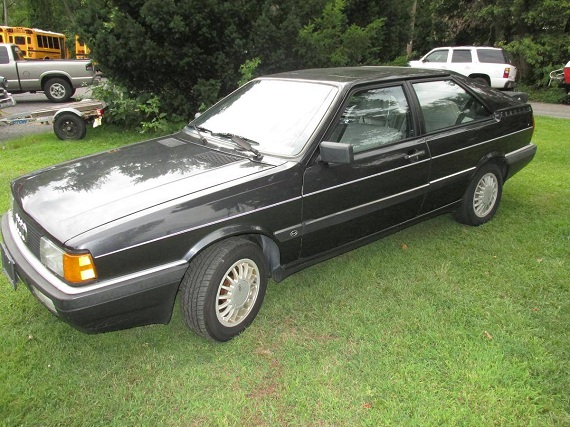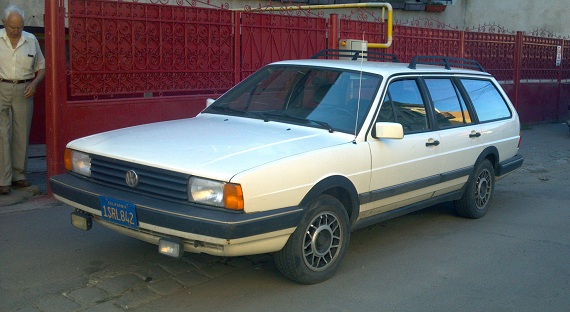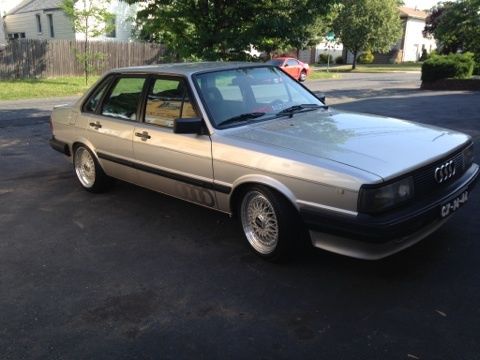Despite praise from critics when it was new, a great design by Giugiaro and a motorsports legacy second to none, the Audi Coupe GT has remained since new a fringe car in the United States. Compared to the E30 2-doors, Audi produced less than half the total production of BMW’s venerable small coupe with only around 170,000 made over its 8 year production run. Of those, many less were imported to the United States and even fewer survive today. They’re downright rare to see running around anywhere – the legacy of poor residual value more than anything. Those that have owned them love them – a great looking, unique coupe with awesome handling that is both at home on the highway and back roads. It’s easily capable of carrying a sizable load of adults and luggage since, like the E30, the GT shared its platform with a sedan – but where the GT differed was in drivetrain layout and the slinky roofline that has helped the car age particularly well. On paper, the GT doesn’t make a great driver – a big iron lump hanging out entirely ahead of the front axle line to allow for the all-wheel drive system we didn’t see in the GT on these shores, an open differential and a slightly heavier curb weight without much more power than the coupes from Volkswagen. But statistics don’t tell the whole story, and GT is a great example of that. Extremely well balanced and neutral out of the box, the longer wheelbase provides excellent stability while the equal-length driveshafts eliminate torque steer and help to put power down better than the Volkswagens. The package is refined and shows why the GT was successful in its own right as a racer in Europe. Plus, you get that wonderful off-beat, throaty inline-5 providing one of the more unique soundtracks from the 1980s:
Tag: B2
In yesterday’s Audi project post, I wrote up two more-rare Audis with potential, though both would require some work and dedication to get to daily driver status. Today, I’ve got two more “project” cars – though, if anything, these two are considerably more rare these days than either of the two Audis. Both are all-wheel drive wagons from Volkswagen, but if you can quint and see a family resemblance, that’s about all that links them together. The first is the B2 Audi-derived Quantum Syncro – essentially, an Audi 4000 quattro with Volkswagen hubs, wheels and brakes and a unique rear suspension under the Quantum body. The Passat W8 also shared Audi A4 all-wheel drive components but essentially was a completely different offering, from the 6-speed manual transmission this model sports to the unique W8 motor stuffed into the discreet Passat Variant package. While there were considerably more Quantum Syncros produced than W8 6-speeds, finding one today can be quite hard – many succumbed to poor residual value, rust and neglect; though not complicated cars, the were more expensive to work on than the standard 4-cylinder models. The W8 is at the verge of falling into the same fate, with the exception of original production numbers – with only a handful of W8 Variants imported originally, both of these cars are serious unicorns these days. Which is your style?
CLICK FOR DETAILS: 1987 Volkswagen Quantum GL5 Syncro Variant on eBay
4 CommentsIn the spectrum of things you wouldn’t expect to see parked next to a tired Ford Taurus at a second-tier used car dealership, to me an original Audi Quattro would rank pretty highly. Couple the exclusivity of the few that were imported with the avid followers that seem to know the movements of virtually every model and you have a recipe for stalker-status enthusiasts that snap up every good example. And a good example this car appears to be; Tornado Red with upgrade 8″ Ronal alloys in rally white and Euro-lights, but otherwise mostly original condition this Quattro looks like one of the best examples that has come to market recently:
CLICK FOR DETAILS: 1983 Audi Quattro on eBay
3 CommentsWhile the Quattro stole all of the headlines for Audi, the reality is that it was an expensive vehicle at the time – very expensive. As a halo car for Audi, the purchase price of the Quattro was around $35,000 in 1983 – more money that most of the competition that was, at least on paper, faster. Remember, a 1983 Porsche 911 coupe would have only set you back around $32,000 at the time. It was, then, the Audi R8 of its day, and like the R8 it had a limited market. Audi’s solution to the problem was to take all of the underpinnings – virtually unchanged – and pop them into the more pedestrian 80 platform. Marked as the 4000S quattro in the U.S., it developed as a legend in its own right, with a carved-from-granite drivetrain that seemed unbreakable and great handling. True, at the best part of 2800 pounds but with only 115 horsepower, it won no drag races, but the versatile small sedan took the Audi fanbase to new levels. It was, in many respects, the Audi S4 of its day. The interior and exterior received substantial upgrades for the 1985 model year, making the first year model a one-year stand that has many fans. They’re rare cars to see today, especially in great condition:
CLICK FOR DETAILS: 1984 Audi 4000S quattro on eBay
3 CommentsThe Quattro remains one of the few attainable halo vehicles from the 1980s. Consider the others; BMW M1s are on the verge of being million dollar cars while most of the rest of the M line appreciates rapidly. For Mercedes-Benz, there were no real “Halo” models for the 1980s in the U.S., but clean and original examples of their flagship models or indeed some of the rare AMG pieces are big business. Porsche has several, with the 930 and good examples of just about every other rear engined example rapidly increasing in value. What’s left? The Quattro should certainly be considered amongst those cars, for one. As a revolutionary piece of engineering, the Quattro firmly placed Audi on the map as a serious contender in the European and North American markets. The were legendary even before they officially raced, as one of the stage cars notoriously outpaced all of the race cars in its first unofficial appearance at a rally. The rest set the stage for the legend; the Quattro amassed 23 WRC victories and two World Championship titles before Audi moved towards road racing with the demise of Group B. Today, despite the top-tier reputation and recognition that it finally deserves, the Quattro remains an affordable option for classic German motoring:




